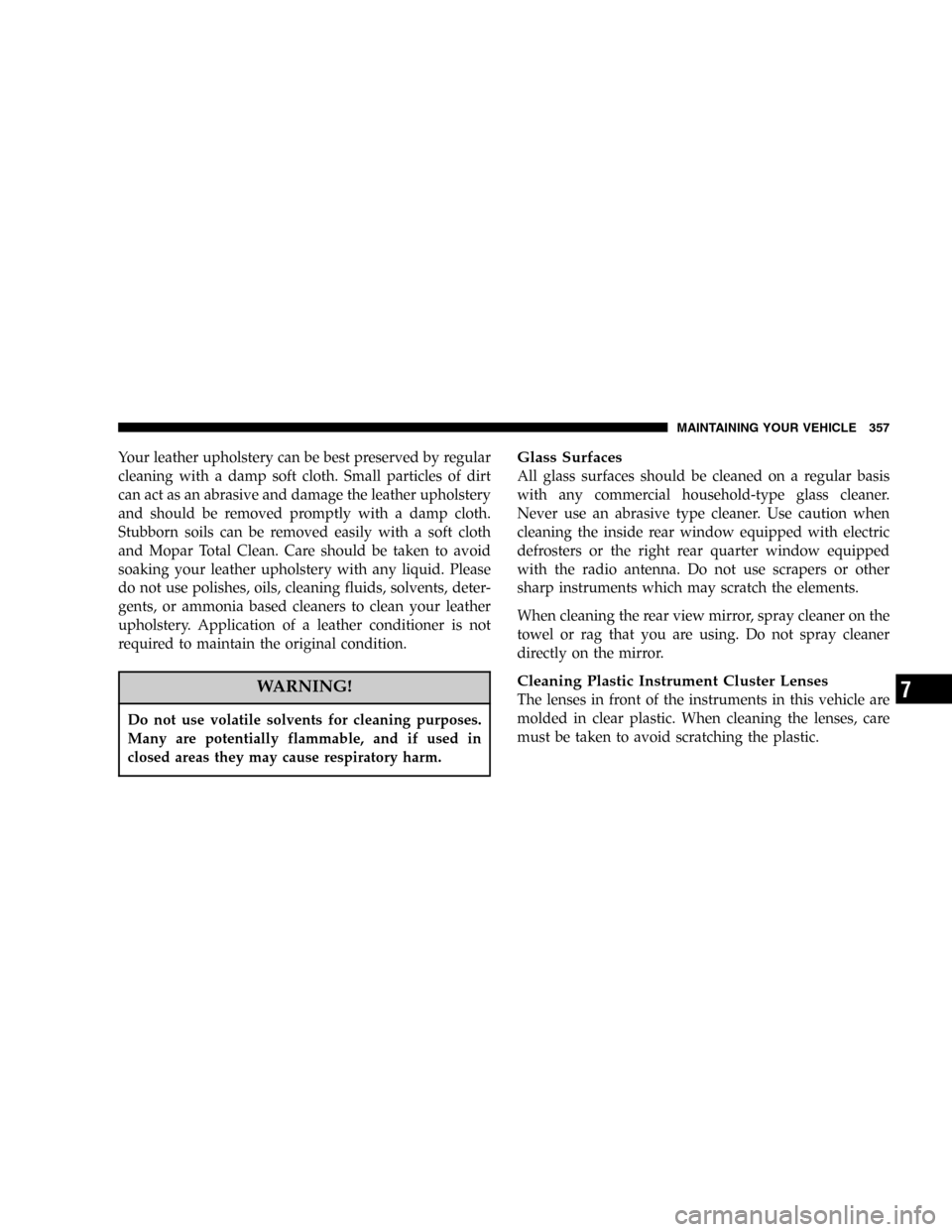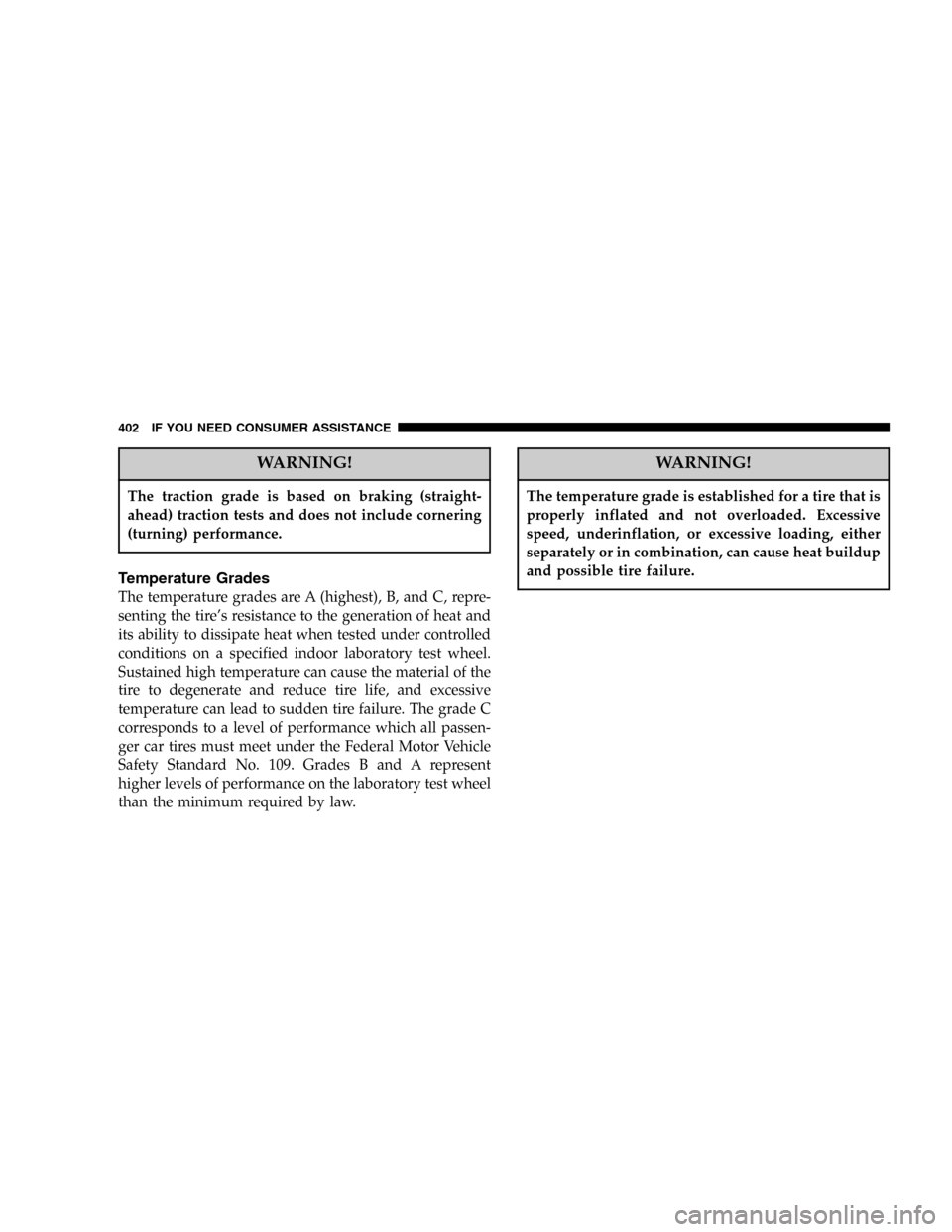Page 347 of 420

Insure nylon tubing in these areas has not melted or
collapsed.
Inspect all hose connections such as clamps and cou-
plings to make sure they are secure and no leaks are
present.
NOTE:Often, fluid such as oil, power steering fluid,
and brake fluid are used during assembly plant opera-
tions to facilitate the assembly of hoses to couplings.
Therefore, oil wetness at the hose-coupling area is not
necessarily an indication of leakage. Actual dripping of
hot fluid when systems are under pressure (during
vehicle operation), should be noted before a hose is
replaced based on leakage.
NOTE:Inspection of brake hoses should be performed
whenever the brake system is serviced and at every
engine oil change. Inspect hydraulic brake hoses for
surface cracking, scuffing, or worn spots. If there is any
evidence of cracking, scuffing, or worn spots, the hoseshould be replaced immediately! Eventual deterioration
of the hose can take place resulting in a possibility of a
burst failure.
WARNING!
Worn brake hoses can burst and cause brake failure.
You could have an accident. If you see any signs of
cracking, scuffing, or worn spots, have the brake
hoses replaced immediately.
Master Cylinder—ABS Brakes Brake Fluid Level
Check
The fluid level in the master cylinder should be checked
when performing underhood services, or immediately if
the brake system warning light indicates system failure.
MAINTAINING YOUR VEHICLE 347
7
Page 348 of 420

Clean the top of the master cylinder area before removing
the cap. Add fluid to bring the level up to the top of the
“FULL”mark on the side of the master cylinder reservoir.
Overfilling of fluid is not recommended because it may
cause leaking in the system.
Add enough fluid to bring the level up to the require-
ments described on the brake fluid reservoir. With disc
brakes, fluid level can be expected to fall as the brake
pads wear. However, low fluid level may be caused by a
leak and a checkup may be needed.
Use only manufacturers recommended brake fluid, refer
to Recommended Fluids, Lubricants and Genuine Parts
for correct fluid type.WARNING!
•Overfilling the brake fluid reservoir can result in
spilling brake fluid on hot engine parts and the
brake fluid catching fire.
•Use of brake fluid that may have a lower initial
boiling point or unidentified as to specification,
may result in sudden brake failure during hard
prolonged braking. You could have an accident.
Use only brake fluid that has been in a tightly closed
container to avoid contamination from foreign matter or
moisture.
348 MAINTAINING YOUR VEHICLE
Page 357 of 420

Your leather upholstery can be best preserved by regular
cleaning with a damp soft cloth. Small particles of dirt
can act as an abrasive and damage the leather upholstery
and should be removed promptly with a damp cloth.
Stubborn soils can be removed easily with a soft cloth
and Mopar Total Clean. Care should be taken to avoid
soaking your leather upholstery with any liquid. Please
do not use polishes, oils, cleaning fluids, solvents, deter-
gents, or ammonia based cleaners to clean your leather
upholstery. Application of a leather conditioner is not
required to maintain the original condition.
WARNING!
Do not use volatile solvents for cleaning purposes.
Many are potentially flammable, and if used in
closed areas they may cause respiratory harm.
Glass Surfaces
All glass surfaces should be cleaned on a regular basis
with any commercial household-type glass cleaner.
Never use an abrasive type cleaner. Use caution when
cleaning the inside rear window equipped with electric
defrosters or the right rear quarter window equipped
with the radio antenna. Do not use scrapers or other
sharp instruments which may scratch the elements.
When cleaning the rear view mirror, spray cleaner on the
towel or rag that you are using. Do not spray cleaner
directly on the mirror.
Cleaning Plastic Instrument Cluster Lenses
The lenses in front of the instruments in this vehicle are
molded in clear plastic. When cleaning the lenses, care
must be taken to avoid scratching the plastic.
MAINTAINING YOUR VEHICLE 357
7
Page 365 of 420
High Intensity Discharge Headlights (HID)—If
Equipped
The headlights are a type of high voltage discharge tube.
High voltage can remain in the circuit even with the
headlight switch off and the key removed.Because of
this, you should not attempt to service a headlight bulb
yourself. If a headlight bulb fails, take your vehicle to
an authorized dealer for service.
WARNING!
A transient high tension occurs at the bulb sockets of
High Intensity Discharge (HID) headlights when the
headlight switch is turned ON. It may cause serious
electrical shock or electrocution if not serviced prop-
erly. See your authorized dealer for service.
NOTE:On vehicles equipped with High Intensity Dis-
charge Headlights (HID), when the headlights are turned
on there is a blue hue to the lights. This diminishes and
becomes more white after approximately 10 seconds, as
the system charges.
MAINTAINING YOUR VEHICLE 365
7
Page 391 of 420
* This maintenance is recommended by the manufacture
to the owner but is not required to maintain the emis-
sions warranty.
‡This maintenance is not required if previously replaced.
Inspection and service should also be performed anytime
a malfunction is observed or suspected. Retain all re-
ceipts.WARNING!
You can be badly injured working on or around a
motor vehicle. Do only that service work for which
you have the knowledge and the right equipment. If
you have any doubt about your ability to perform a
service job, take your vehicle to a competent me-
chanic.
SCHEDULE“A”391
8
M
A
I
N
T
E
N
A
N
C
E
S
C
H
E
D
U
L
E
S
Page 402 of 420

WARNING!
The traction grade is based on braking (straight-
ahead) traction tests and does not include cornering
(turning) performance.
Temperature Grades
The temperature grades are A (highest), B, and C, repre-
senting the tire’s resistance to the generation of heat and
its ability to dissipate heat when tested under controlled
conditions on a specified indoor laboratory test wheel.
Sustained high temperature can cause the material of the
tire to degenerate and reduce tire life, and excessive
temperature can lead to sudden tire failure. The grade C
corresponds to a level of performance which all passen-
ger car tires must meet under the Federal Motor Vehicle
Safety Standard No. 109. Grades B and A represent
higher levels of performance on the laboratory test wheel
than the minimum required by law.
WARNING!
The temperature grade is established for a tire that is
properly inflated and not overloaded. Excessive
speed, underinflation, or excessive loading, either
separately or in combination, can cause heat buildup
and possible tire failure.
402 IF YOU NEED CONSUMER ASSISTANCE
Page 404 of 420

Adding Fuel........................... 290
Adding Washer Fluid..................128,339
Additives, Fuel......................... 289
Adjustable Pedals....................... 133
Air Conditioner Maintenance............... 335
Air Conditioning.....................223,228
Air Conditioning Controls................. 223
Air Conditioning Filter.................243,336
Air Conditioning Refrigerant............... 335
Air Conditioning System..........223,228,232,335
Air Conditioning System, Zone Control........ 224
Air Pressure, Tires....................... 273
Airbag................................ 44
Airbag Deployment....................... 56
Airbag Light...................48,50,58,69,173
Airbag Maintenance....................... 58
Airbag, Window......................... 45
Alarm System........................... 25
Alignment and Balance................... 280All Wheel Drive...................255,281,352
Alterations/Modifications, Vehicle............. 7
Antenna, Satellite Radio................... 217
Antifreeze (Engine Coolant)...........341,342,368
Disposal............................ 344
Anti-Lock Brake System (ABS).............. 258
Anti-Lock Warning Light.................. 166
Anti-Theft Security Alarm.................. 25
Appearance Care........................ 354
Arming Theft System...................... 25
Auto Down Power Windows................ 31
Automatic Dimming Mirror................. 76
Automatic Door Locks...................17,18
Automatic Headlights.................... 123
Automatic Temperature Control............. 232
Automatic Transaxle...................... 251
Adding Fluid......................... 370
Interlock System....................... 252
Reset Mode.......................... 252
404 INDEX
Page 405 of 420

Selection Of Lubricant................349,370
Shifting............................. 253
Special Additives...................... 352
Automatic Transmission................... 349
Adding Fluid......................... 350
Fluid and Filter Changes................. 351
Fluid Change......................... 351
Fluid Level Check...................... 350
Fluid Type........................... 349
Autostick........................135,253,254
Ball Joints............................. 337
Battery............................... 333
Gas Caution.......................... 334
Jump Starting......................... 309
Keyless Transmitter Replacement............ 24
Bearings.............................. 354
Belts, Drive............................ 330
Body Mechanism Lubrication............... 338B-Pillar Location........................ 268
Brake, Parking.......................... 256
Brake System........................258,346
Anti-Lock........................... 258
Fluid Check.......................347,370
Hoses.............................. 346
Warning Light........................ 167
Brakes.............................258,346
Brake/Transmission Interlock............... 251
Break-In Recommendations, New Vehicle........ 67
Bulb Replacement....................... 364
Bulbs, Light............................ 363
Calibration, Compass..................... 180
Capacities, Fluid........................ 368
Caps, Filler
Fuel................................ 290
Oil (Engine).......................328,329
Radiator (Coolant Pressure)............... 343
INDEX 405
10